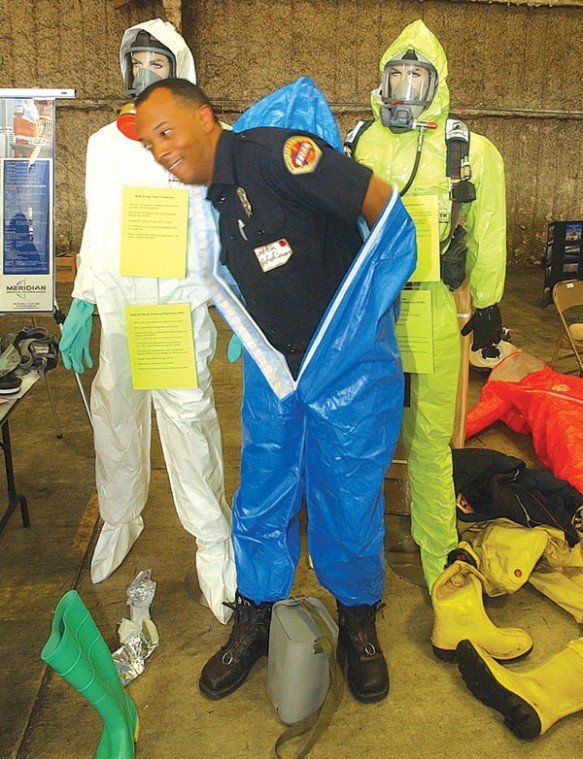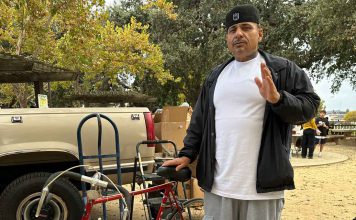Gilroy
– The arm of a bomb squad robot slowly extended toward a
suspicious package lying on the ground inside a warehouse at
Christopher Ranch.
By Lori Stuenkel
Gilroy – The arm of a bomb squad robot slowly extended toward a suspicious package lying on the ground inside a warehouse at Christopher Ranch.
The movements of the robot – scarred from a previous pipe bomb explosion – were controlled by Deputy Greg Taylor, using a computer from inside a nearby Santa Clara County Sheriff’s Office Bomb Squad van, called a Total Containment Vessel. If Taylor wanted, he could view the would-be bomb using X-ray vision or destroy it using a high-powered stream of water.
Those steps were unnecessary, though, because no lives were at risk and the “suspicious package” was actually a harmless box. Taylor and Sgt. Brian Washburn were making a presentation to members of law enforcement groups from Gilroy and around the county during the first of six training sessions to be held in different locations through Tuesday.
Funded by a $300,000 Department of Homeland Security grant and administered by the county Office of Emergency Services, the trainings are the first step in coordinating local emergency responders in the event of a large-scale terrorist attack, be it a bombing or biological weapon attack.
“This is awareness-level training for responders to incidents of weapons of mass destruction or other terrorist incidents,” said Sgt. Skip Shervington with the Sheriff’s Special Operations Division. “It gives all agencies a chance to see what the other jobs are.”
In the event of an attack or hazardous materials incident affecting hundreds of people, local emergency responders now have a better idea of where Incident Command might be set up, how to control the scene if expertly trained responders are needed and how other agencies will be doing their jobs.
“It gets everybody up to speed to know what our resources are,” Gilroy Fire Division Chief Clay Bentson said.
Getting different disciplines of first responders together in one space for classroom and hands-on demonstrations could mean Gilroyans are better protected during a weapons of mass destruction or chemical agent attack: The focus, Shervington said, was on knowing how to deal with emergency situations before additional resources arrive.
More than two dozen Gilroy firefighters and police officers attended one of two trainings held at Christopher Ranch Wednesday morning and afternoon, joined by dozens more of deputy sheriffs; San Jose, Santa Clara city, California Department of Forestry/South County and Santa Clara County firefighters; public health workers; ambulance drivers; Bureau of Alcohol, Tobacco and Firearms agents; and city workers, among others.
“We’re typically going to be first responders to most of these incidents,” GPD Capt. Scot Smithee said. “When a law enforcement officer pulls up at the scene, they will have to determine what are the tools we need to respond to this, and then to know what we need to do.”
Smithee was examining technical rescue equipment, which along with the bomb squad robot, was one of five demonstration areas set up at the Ranch warehouse. There also were presentations from various experts on triage, decontamination and personnel protective equipment.
“It’s kind of cool to be able to come and see the stuff, where you can actually touch it and use it,” said Smithee, who like many of the participants had just practiced using a nerve agent autoinjector, which provides life-saving antidotes to responders.
The technical rescue equipment on display Wednesday was a sampling of what will be stored in trailers at four locations in the county – including a Gilroy fire station – for use at certain emergencies or attacks. The trailers contain specialized equipment that can be used in a more advanced rescue situation. Another part of the Department of Homeland Security grant funded each of the $125,000 trailers, which will be shared by county agencies.
Over at the decontamination area, three systems of flushing patients were on display: Two Gilroy fire engines set 15 to 20 feet apart that spray water between them; a series of box rollers over which patients on gurneys are pushed and cleaned by hand; and a $10,000 tent that offers progressive decontamination, spraying patients as they walk through.
“The fire departments are very familiar with basic (decontamination) – a (hazardous materials) situation dealing with maybe two or three people,” said Phil King, GFD paramedics division chief, “But it’s a whole different ball game when you’re decontaminating 50 to 100 people.”
The Homeland Security training is a three-year process, said Kelly Seitz, a captain with Santa Clara County Fire. At the same time all responders are receiving “awareness-level” training, others are receiving more specialized training, depending on their disciplines. The next step is “table-top” exercises, in which administrators from different agencies will work out policies and procedures for different events. Eventually, all the county’s first responders will combine resources for a mock terrorist attack.
“We have to train for an ‘all-event’ scenario, so we don’t really know what that will be – we have to train for all different possibilities,” Shervington said. “We have our specific targets in this area that have been identified as possible targets of terrorist attacks, just as all regions have identified targets.”












